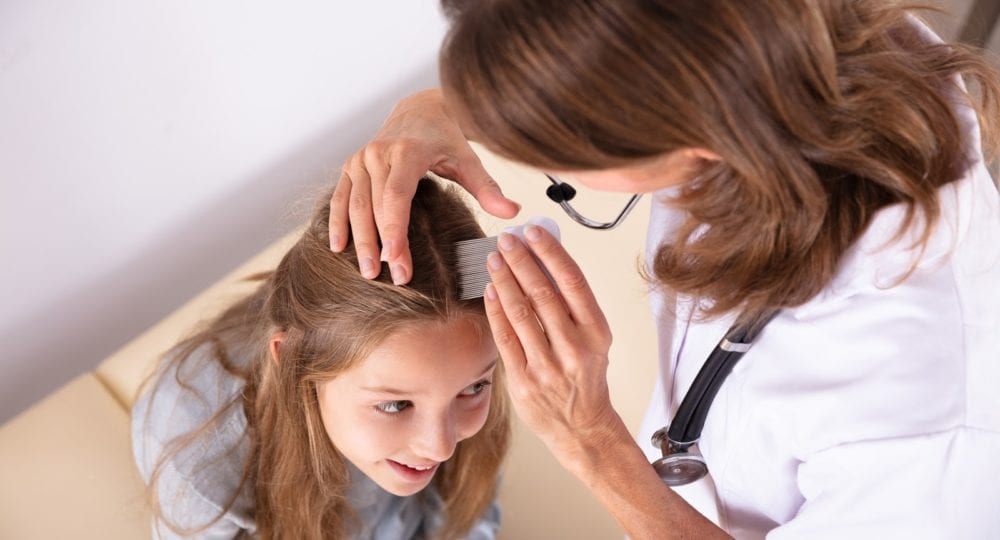The Centers for Disease Control and Prevention (CDC) estimates that 6-12 million head lice infestations occur each year in the United States among children 3-11 years old. With kids heading back to school, September is a prime month to raise awareness about head lice.
Head lice are parasitic insects that can live on a person’s head, eyebrows, and eyelashes. They are about 2-3 mm long (the size of a sesame seed) and they feed on small amounts of human blood. They are found worldwide, and they don’t discriminate. They can be found on heads with dirty or clean hair, in rural and urban areas, and in high- and low-income families. In case you’re already panicking about these minuscule creepy crawlies, the good news is that they are not known to spread disease and they can be treated at home.
Head lice are most common on the scalp around and behind the ears and near the neckline at the back of the head. They lay and attach eggs, known as nits, on hair close to the scalp. Nits are white or yellow in color. The life span of head lice is about 28 days. Adult lice can lay up to 10 eggs a day, so they multiply quickly.
Contrary to a commonly held belief, head lice cannot jump or fly, they only crawl. They can, however, live 1-2 days without a meal and can, therefore, survive on other objects during that time. They usually spread from those infested with head lice to others in these ways:
- Direct head-to-head contact (most common)
- Contact with clothing (e.g. hats, scarves, coats)
- Contact with other personal items (e.g. combs, brushes, towels, stuffed animals)
- Laying on a couch, pillow or carpet recently in contact with an infested person
Itching is the most common symptom of having head lice. It may take 4-6 weeks from the time of first getting lice for symptoms to show up, which is why it is important to perform regular checks on your children and catch lice before they have time to multiply. Lice are often hard to spot as they tend to avoid light and move quickly. Nits are much smaller than lice and, because of their white/yellow color, will be especially difficult to find on similarly colored hair. Nits may also be confused with dandruff or hair product residue. The way to differentiate a nit is that it will be firmly attached to hair, whereas other things will move or fall off easily.
In the event your child does get head lice, here are some recommendations from the American Association of Pediatrics (AAP) and CDC in treating them:
- First, check with your child’s doctor before beginning a treatment
- Head lice medicine is the most effective treatment
- There are both over-the-counter and prescription options
- It is extremely important to follow the safety guidelines on the package because they can be harmful if used incorrectly
- After a treatment, it is also very important to use the “comb-out” method
- Wet hair
- Use a very fine-tooth comb (can find lice specific combs) to comb through all hair in small sections
- After each comb through, wipe comb on a wet paper towel and inspect
- May need to repeat treatment 7-10 days later depending on the medicine
- Make sure to get rid of lingering head lice elsewhere
- Wash the child’s clothes, towels, hats, bed linens, and stuffed animals in hot water and dry on high heat if they were used within 2 days before head lice were treated
- Items that can’t be washed can be dry cleaned or sealed in a plastic bag for 2 weeks
- Soak combs and brushes in hot water for 5-10 minutes
- Vacuum the floor and furniture
There are many home remedies that also claim to treat head lice. However, no scientific studies have found that any of these alternative treatments are effective. Some examples include mayonnaise, petroleum jelly, and herbal oils.
In some areas, there are lice treatment clinics available where lice are treated and removed by professionals without the use of chemicals. Visits to these clinics may be covered at least in part by health insurance.
Some schools have “no nit” policies that state students who still have nits in their hair cannot return to school. The AAP and National Association of School Nurses discourage such policies and believe a child should not be excluded from school because of head lice, but ultimately these policies are determined by local school boards.
Remember, if your child gets head lice there is no reason to panic. There is no risk of serious health problems from head lice. Do, however, work quickly and safely to treat your child and thereby prevent the head lice from spreading!
Resources:





